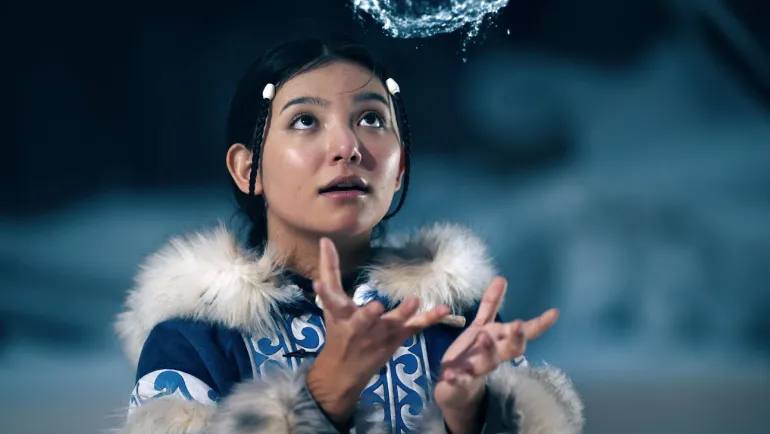Netflix’s reimagining of Avatar: The Last Airbender is a refreshing take on the beloved cartoon series. Instead of simply retelling the story, this adaptation delves deeper into the characters, giving viewers a more intimate look at their journeys. While it may have its flaws, such as unconvincing special effects and rushed storytelling, it still manages to capture the essence of the original series. Unlike M. Night Shyamalan’s failed attempt at bringing Aang’s adventure to life, this new adaptation stays true to the heart of the show. Ultimately, it’s the focus on character development and emotional depth that sets this version apart and makes it a worthy addition to the Avatar universe.
In the captivating story of Avatar: The Last Airbender, Aang is faced with the daunting task of restoring balance to a war-torn world. As the last Airbender, he must grapple with the trauma of losing his people and the weight of being the Avatar. Despite his young age, Aang rises to the challenge with kindness and determination, striving to be a peacemaker and savior for the world. The series beautifully explores how Aang's past shapes his future and emphasizes his role as a beacon of hope in a world torn apart by conflict. Avatar: The Last Airbender is a powerful tale of resilience, courage, and the enduring power of compassion.
Character Depth and Tone Shift
The portrayal of the genocidal Fire Nation in Avatar: The Last Airbender not only highlights the devastation of the world but also emphasizes the loss and tragedy that Aang has experienced. The transition to live-action brings a more mature and grounded tone to the series, allowing Aang's unwavering compassion and anti-war philosophy to stand out even more. While some of the original silliness and whimsy may be lost in the adaptation, the darker vibe serves the story well by showcasing the importance of Aang's values in a world torn apart by violence. Avatar: The Last Airbender remains a powerful and thought-provoking series that continues to resonate with audiences.
Gordon Cormier, Kiawentiio, and Ian Ousley shine as the young actors portraying Aang, Katara, and Sokka in the live-action adaptation of Avatar. Cormier's performance as Aang is particularly noteworthy, as he brings to life the playful and adventurous spirit of the character while also showcasing the weight of the responsibilities placed upon him. At just 12 years old, Cormier impressively carries the lead role with maturity and depth, embodying the essence of Aang with authenticity and charm. Kiawentiio and Ousley also deliver strong performances, capturing the essence of their characters and bringing a sense of camaraderie to the trio.
Together, they form a solid group of actors who do justice to the beloved core trio of Avatar. Sokka is undoubtedly the funniest character in the group, using his humor to lighten the mood and voice the audience's thoughts when strange events occur in a world filled with martial artists who can manipulate the elements. His sister, Katara, has her moments of delivering moving words as the emotional center of the team, but sometimes her character falls a bit flat. Despite this, witnessing the three characters form strong bonds of friendship and learn to work together as a team provides some of the most enjoyable moments in the show.
Bonds of Friendship: Enjoyable Moments
As the Avatar, Aang learns to command the elements with tremendous force, but it’s his kind heart that gives him his strength, and it’s to Cormier’s credit that he makes Aang impossible not to root for. It’s of special note how well the choreography captures Aang’s unique way of moving: He excitedly bounces around and casually flutters up into the sky on a whim, like you’d expect from someone who grew up with this power.

He has a fun and cool combat style where he likes to spin and flip on a breeze to counter his opponent, and use his surroundings to his advantage – sort of like a pint-sized Jackie Chan who can fly. It’s worth noting, though, that while all of the environments and settings look stunning, it’s not always convincing when the characters move around in them.
The characters who benefit the most from the changes in this adaptation are undoubtedly the Fire Nation’s Prince Zuko and his uncle, General Iroh, who are on a quest to capture the Avatar. Dallas Liu portrays Zuko with a perfect balance of entitlement and anger, masking the pain he carries within. Meanwhile, Paul Sun-Hyung Lee shines as the wise and humorous yet deeply scarred Iroh. Their bond as outcasts is portrayed beautifully, with flashbacks revealing the tragic events that shaped it. Fans of the original series know that Zuko and Iroh have a compelling storyline, but this retelling adds new layers that enhance the complexity and emotional depth of their relationship.
Spending more time with the Fire Nation characters in the Avatar: The Last Airbender series allows viewers to delve deeper into the character of Fire Lord Ozai. Despite the risk of revealing too much too soon, the decision pays off as we witness the ruthless nature of Ozai in his quest for world domination. Daniel Dae Kim's portrayal of the Big Bad Evil Guy is both steely and intimidating, adding to the character's menacing presence.
Ozai's manipulation of his children, Zuko and Azula, showcases his cruel and unforgiving nature, causing an unfathomable amount of pain and emotional turmoil. Elizabeth Yu's portrayal of Azula is equally impressive, with a cruelty and sadism that is both chilling and captivating. The decision to introduce her early in the series proves to be a wise choice, as her character only grows more unhinged as the story progresses.
Elizabeth Yu's Standout Performance
From the very beginning, it is evident that bending will play a central role in this show, and it does not disappoint. The Earthbenders showcase their power by raising pillars from the ground with thunderous impact, while Firebenders unleash explosive and dazzling attacks reminiscent of Liu Kang. Airbending is portrayed as channeling tornadoes and gales that can blast enemies away with ease. However, Waterbending falls short in comparison, as the liquid often appears plasticky and lacks the impact expected from such a powerful element. Despite this minor flaw, the bending in the show is consistently impressive, adding excitement and wonder to every fight scene.
Aang's journey to master all four elements and confront Ozai is a lengthy one, encompassing three seasons in the original series. However, the live-action adaptation condenses this epic tale into just eight episodes. While this streamlined approach allows for a more focused narrative on Team Avatar's mission to protect the Northern Water Tribe from the Fire Nation, the results are somewhat mixed. Some episodes feel rushed, trying to cram in too much plot in a short amount of time. Despite this, there are moments of brilliance in the writing, as the show manages to blend together key elements from the animated series while also incorporating nods to loyal fans.
Pacing and Coherence Concerns
The show's fast-paced nature may come at the expense of breathing room for all the characters and events, leading to erratic pacing and abrupt conversations. However, when the show takes its time, it offers truly amazing content. Avatar boasts a cast of well-developed characters, each with their own unique missions and philosophies on life. The show shines brightest when it slows down to delve deeper into the complexities of these characters.
The attention to detail in this adaptation is truly impressive. From the imposing black metal warship to the intricate costuming and makeup, every aspect of the production is carefully crafted. The small surprises sprinkled throughout the series, like the intense moment between Iroh and an Earthbender soldier, add depth and intrigue to the story. Whether you are familiar with the source material or not, there is plenty to enjoy in this adaptation. The scale, the music, and the performances all come together to create a captivating viewing experience.
While the new Avatar series has its moments of brilliance, there are also some nagging issues that fans can't help but notice. One of the biggest quibbles is the inconsistency in the Avatar's need for a low profile, as the heroes often seem to forget this rule when they find themselves in a big city.
Additionally, Aang's ability to commune with past Avatars introduces a new twist to the supercharged Avatar State, but this change seems to only serve a singular moment rather than be a consistent part of the show. Furthermore, beloved animal pals Appa and Momo make appearances, but they don't have enough screen time to feel like fully developed characters. While the new series has its strengths, there are certainly some areas that could use improvement.

The spiritual side of the world in “Avatar: The Last Airbender” feels underdeveloped, leaving viewers feeling somewhat confused when the importance of the Spirit World and the Avatar's connection to it becomes more prominent later on. While some time is devoted to explaining how the Spirit World works, it is not enough to fully understand its significance in the series. As a result, there is a sense of confusion when supernatural occurrences and glowy things start happening, highlighting a missed opportunity for deeper exploration of the spiritual elements in the show.
Verdict
The live-action adaptation of Avatar: The Last Airbender was always going to face high expectations and intense scrutiny from fans of the original animated series. However, over the course of its eight episodes, the new Avatar manages to find its own stride and capture the essence of the beloved characters and world.
While it may not live up to every aspect of the original, the adaptation adds a richness and depth to the lore that is both refreshing and engaging. By staying true to the spirit of the original while also carving out its own unique path, the new Avatar succeeds in showcasing the flawed yet lovable characters in a new light, ultimately proving itself as a worthy addition to the Avatar universe.




